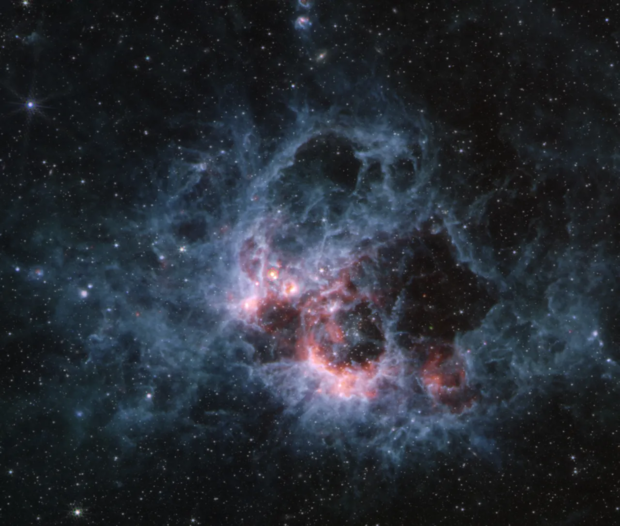Dazzling new images from Webb telescope reveal "ghostly glow" of newborn stars
A stellar nursery filled with hundreds of blistering-hot and massive newborn stars is captured in two new images by the James Webb Space Telescope, which showcase the uniquely dense region of outer space in stunning detail.
The images were produced by the Webb telescope's Near-Infrared Camera and Mid-Infrared Instrument, or NIRCam and MIRI, giving complementary views of a star-forming region in the Triangulum galaxy that scientists have dubbed NGC 604. Estimated to be around 3.5 million years old, the region is home to more than 200 of the hottest and largest types of stars, all of which are "in the early stages of their lives," the NASA Webb Mission Team said in a statement unveiling the new images. Young stars pictured in them are categorized as B-type and O-type — referring mainly to their physical makeup — and those that fall into the latter category can be especially huge. Some are more than 100 times as big as the sun in our solar system.
"It's quite rare to find this concentration of them in the nearby universe. In fact, there's no similar region within our own Milky Way galaxy," the Webb Mission Team said. The Triangulum galaxy, at 2.73 million light-years from Earth, is considered nearby.
Because of its relatively close distance, and because Triangulum's star-forming region is so concentrated, the data collected by Webb to produce these new images has allowed astronomers to begin studying the stars as newborns. The Webb team called this "a fascinating time" as the process of star birth is still one of the most mysterious and complex phenomena in the universe despite also being a popular subject of scientific investigation.
In one of the two new images of NGC 604, produced by the Webb telescope's NIRCam, dusty tendrils and clumps of emission appear bright red and splay out from a series of spherical spaces, described as "large bubbles in the nebula."
"Stellar winds from the brightest and hottest young stars have carved out these cavities, while ultraviolet radiation ionizes the surrounding gas," the Webb team said. "This ionized hydrogen appears as a white and blue ghostly glow."
Other sections of the image that appear bright orange likely mark the presence of carbon-based molecules called polycyclic aromatic hydrocarbons, which scientists know are involved in the formation of stars and planets. How and where these molecules originate in the universe is still unknown.
A second image of NGC 604, captured by MIRI, shows the region in mid-infrared wavelengths. This view includes fewer stars "because hot stars emit much less light at these wavelengths, while the larger clouds of cooler gas and dust glow," the Webb team said. The image also captures some stars from the surrounding galaxy called red supergiants, which are cool and very large.
NASA has shared remarkable images of newborn star clusters before, also taken by the Webb telescope. To mark the first anniversary of Webb's outer-space observations last July, the agency released an image of a stellar nursery in the Rho Ophiuchi cloud complex, which it said at the time was the closest star-forming region to Earth. That region contained about 50 young stars that were all similar in size to the sun in our solar system, or smaller.





